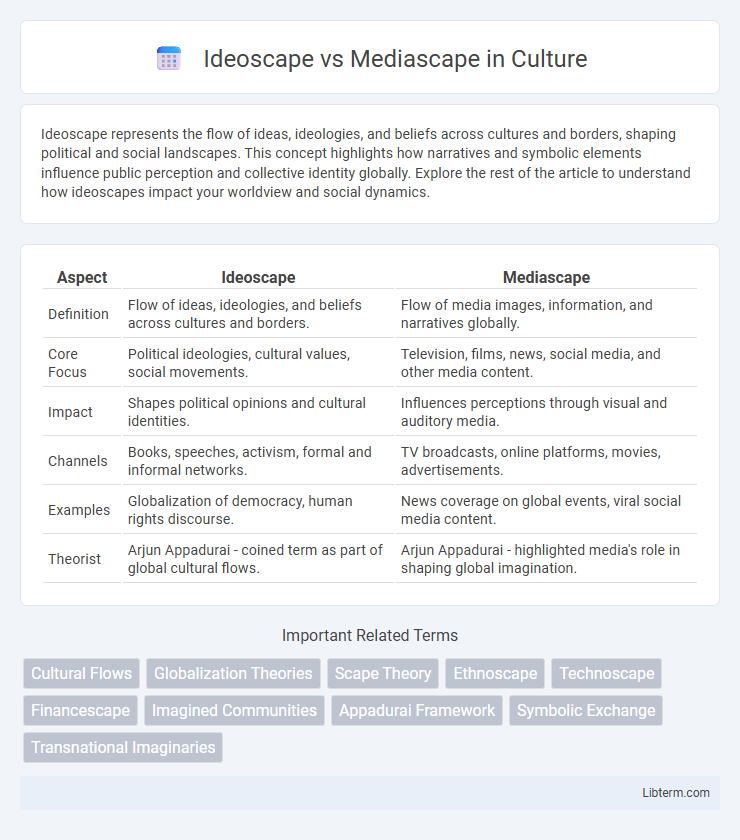Ideoscape represents the flow of ideas, ideologies, and beliefs across cultures and borders, shaping political and social landscapes. This concept highlights how narratives and symbolic elements influence public perception and collective identity globally. Explore the rest of the article to understand how ideoscapes impact your worldview and social dynamics.
Table of Comparison
| Aspect | Ideoscape | Mediascape |
|---|---|---|
| Definition | Flow of ideas, ideologies, and beliefs across cultures and borders. | Flow of media images, information, and narratives globally. |
| Core Focus | Political ideologies, cultural values, social movements. | Television, films, news, social media, and other media content. |
| Impact | Shapes political opinions and cultural identities. | Influences perceptions through visual and auditory media. |
| Channels | Books, speeches, activism, formal and informal networks. | TV broadcasts, online platforms, movies, advertisements. |
| Examples | Globalization of democracy, human rights discourse. | News coverage on global events, viral social media content. |
| Theorist | Arjun Appadurai - coined term as part of global cultural flows. | Arjun Appadurai - highlighted media's role in shaping global imagination. |
Understanding Ideoscape and Mediascape: Key Differences
Ideoscapes refer to the flow of ideologies and political ideas across different cultures, influencing collective consciousness and social movements worldwide. Mediascapes encompass the distribution and consumption of information through various media platforms, shaping public perception and cultural narratives. Understanding the key differences highlights that ideoscapes primarily involve the transmission of abstract ideologies, while mediascapes focus on concrete media content and communication channels.
Historical Origins of Ideoscapes and Mediascapes
Ideoscapes originated from the flow of ideologies and political ideas shaped by historical movements such as nationalism, colonialism, and global political shifts during the 20th century. Mediascapes evolved with the expansion of mass media technologies like television, radio, and later the internet, fundamentally altering how information and cultural narratives are disseminated worldwide. Both concepts were introduced in the context of globalization studies to explain how cultural and ideological landscapes are constructed through communication and media flows.
Theoretical Foundations: Appadurai’s Five Scapes
Ideoscape and Mediascape are two of Arjun Appadurai's five scapes, representing flows of ideas and communication technologies that shape cultural and political landscapes globally. Ideoscape encompasses the transnational flow of ideologies, political ideas, and narratives that influence identity and governance, while Mediascape refers to the electronic and print media networks distributing images and information across borders. Both scapes highlight the fluidity of cultural exchange in the globalized world, emphasizing the role of imagination and perception in forming social realities.
How Ideoscapes Shape Global Political Narratives
Ideoscapes are ensembles of ideas, symbols, and narratives that influence political ideologies and movements worldwide, shaping global political narratives by framing concepts like freedom, justice, and rights in distinct cultural and ideological contexts. Unlike mediascapes, which distribute information through channels such as television, newspapers, and digital media, ideoscapes embed deeper political meanings and aspirations that mobilize collective identities and drive transnational activism. The power of ideoscapes lies in their ability to construct shared visions that transcend national boundaries, fostering ideological alignment and contestation in global politics.
Mediascapes and the Flow of Information
Mediascapes refer to the complex distribution networks and media channels that disseminate images, narratives, and information on a global scale, shaping public perception and cultural understanding. The flow of information within mediascapes is dynamic and multilayered, involving television, film, newspapers, and digital platforms that influence ideologies and social consciousness. Mediascapes enable the globalization of communication, allowing ideas to traverse borders rapidly, impacting political movements, cultural exchanges, and economic trends worldwide.
Interactions Between Ideoscape and Mediascape in Modern Society
Interactions between ideoscape and mediascape shape public perception by dynamically blending cultural ideologies with media flows, influencing identities and social movements globally. Mediascape disseminates ideoscapes through films, news, and digital platforms, allowing rapid propagation and reinterpretation of political and cultural narratives. In modern society, this interplay drives global connectivity and contests power structures by molding collective consciousness and facilitating transnational dialogue.
Ideoscape vs Mediascape: Impact on Cultural Identity
Ideoscape shapes cultural identity by circulating political ideas, ideologies, and belief systems that influence collective consciousness and social values, while Mediascape impacts cultural identity through the dissemination of images, narratives, and media content that frame perceptions of reality and cultural norms. Ideoscape-driven narratives often promote ideological cohesion or resistance, reinforcing or challenging identity frameworks, whereas Mediascape contributes to the construction and globalization of cultural symbols and identities via mass communication technologies. The interplay between Ideoscape and Mediascape determines how individuals internalize cultural meanings, negotiate identity boundaries, and engage with global cultural flows.
The Influence of Technology on Mediascapes
Technology continuously transforms mediascapes by expanding digital platforms, enabling faster and more diverse content dissemination globally. The rise of streaming services, social media, and mobile devices reshapes audience engagement and content consumption patterns. Innovations such as artificial intelligence and augmented reality increasingly personalize and enrich media experiences, influencing cultural narratives within mediascapes.
Case Studies: Ideoscape and Mediascape in Global Events
Case studies of Ideoscape and Mediascape in global events reveal distinct mechanisms of influence and perception shaping. The Arab Spring demonstrated Ideoscape through the spread of democratic ideals via social media platforms, while Mediascape influenced international narratives by framing the events through global news outlets. Similarly, during the COVID-19 pandemic, Ideoscape manifested in public health ideologies promoted globally, whereas Mediascape controlled the dissemination of information and misinformation affecting public response worldwide.
Future Trends: Evolving Boundaries Between Ideoscape and Mediascape
Future trends indicate a growing convergence between Ideoscape and Mediascape, driven by digital platforms that blur the lines between ideological content and media dissemination. Artificial intelligence and augmented reality technologies will further integrate personalized ideological narratives within immersive media environments. This evolution reshapes global communication landscapes, influencing public opinion formation and cultural exchanges at unprecedented scales.
Ideoscape Infographic

 libterm.com
libterm.com